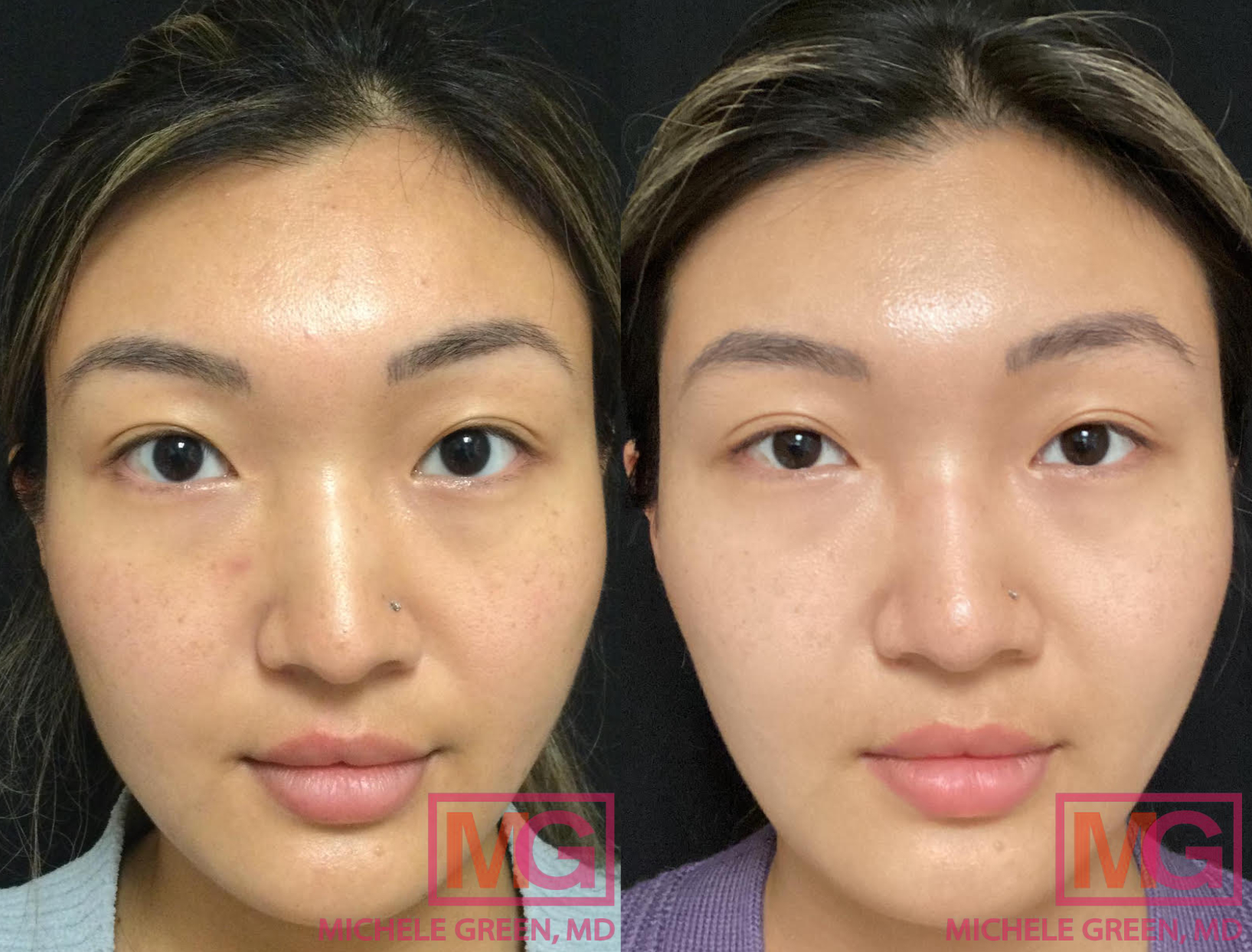Best Botox Injections in New York
If you notice fine lines and wrinkles developing due to repeated facial expressions or are interested in preventing them from forming in the first place, Botox could be just the noninvasive cosmetic solution for you. Thanks to cosmetic injectables like Botox and dermal fillers such as Sculptra, Juvederm, and Restylane, Dr. Michele Green in NYC can provide her patients with pan-facial rejuvenation in a single treatment session. When working with Dr. Green, you can discuss your skin concerns and personal aesthetic goals to develop a treatment plan tailored to you that meets your cosmetic needs.
Since Botox® was approved by the FDA for cosmetic use in 2002, the injectable has skyrocketed in popularity. Botox is currently the number one noninvasive aesthetic medical procedure performed in the United States. Botox, AKA botulinum toxin, is a neuromodulator that essentially ‘freezes’ targeted facial muscles by blocking nerve signals that control expression. By doing so, Botox effectively reduces the ability of the muscle to have full movement. Botox injections diminish the overall appearance of fine lines and wrinkles that develop as a result of repeated facial expressions. Botox is celebrated in the world of cosmetic dermatology due to the ease and speed of performing injections and consistently stunning results with no recovery time involved.
Dr. Michele Green is an Allergan platinum injector of Botox in NYC and a leader in cosmetic injectables and noninvasive facial treatments. Dr. Green has been described as providing the “best Botox in New York,” with over two decades of experience in Botox injections. Her “less is more” philosophy and natural-looking results will leave you the best version of yourself. “The goal is to look rejuvenated and not ‘frozen’ when it comes to Botox and dermal fillers,” says Dr. Green. Combining “Baby Botox” injections, preventative Botox, and “Botox Sprinkles,” Dr. Green’s unique technique for Botox treatments will leave you younger looking after a single visit to her boutique private New York City dermatology office.
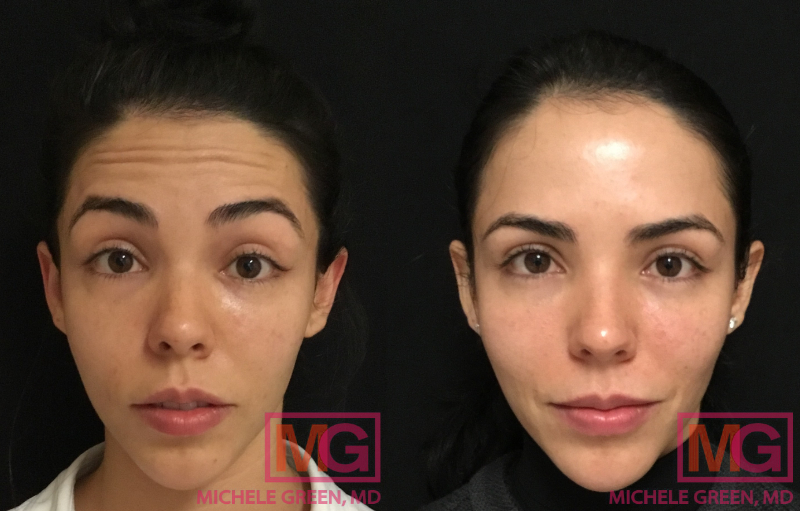
Botox 3 weeks before and after
Botox NYC & Botox Cosmetic Injections
Botox NYC treatment has become one of the most popular cosmetic treatments in the USA since being approved by the US Food and Drug Administration (FDA) for the treatment of glabella wrinkles in 2002. After extensive clinical trials, Botox injections were approved for cosmetic use. Dr. Michele Green was one of the first healthcare providers in NYC to offer cosmetic Botox injections and has been at the forefront of facial rejuvenation treatments in cosmetic dermatology for over 25 years. Dr. Green has been described as one of the best Botox injectors in NYC.
Botox was created by Allergan, an AbbVie company, and its indications for use and popularity have both increased exponentially over the years. Before Botox and other cosmetic injectables were invented, patients were forced to have invasive cosmetic procedures, such as facelifts and other plastic surgery for facial rejuvenation. Botox was the first drug to use botulinum toxin. There are many other competitors now on the market, including abobotulinumtoxinA (Dysport), rimabotulinumtoxinB (Myobloc), incobotulinumtoxinA (Xeomin), prabotulinumtoxin-A (Jeuveau), and daxibotulinumtoxinA (Revance). Daxxify, the latest neurotoxin on the market, espouses a longer duration of activity of approximately six months.
Thanks to cosmetic injectables like Botox, Xeomin, Dysport, and other dermal filler products such as Sculptra, Restylane, and Juvederm Voluma, pan facial rejuvenation can be accomplished in a single treatment session. Botox was first developed and used by ophthalmologists to help treat poor eye muscle control. Quickly, the cosmetic benefits of Botox were discovered, and it could make facial wrinkles disappear. Now, Botox is a household name, with celebrities and stars having Botox treatments as part of their beauty secret. While there are many medspas and medical spas midtown in New York that offer free consultations and “bargain” Botox, Dr. Green provides experience, precision, and the skills to have the most beautiful, best Botox results in her discreet Upper East Side NYC dermatology office.
What is Botox Cosmetic made of?
Botox Cosmetic is an injectable drug developed by Allergan that was FDA-approved in 2002 for cosmetic uses. It contains the active ingredient botulinum toxin type A (onabotulinumtoxina) and the inactive ingredients human albumin and sodium chloride. Botulinum toxin type A is a protein derived and purified from the bacterium Clostridium Botulinum. The human albumin and sodium chloride stabilize the botulinum toxin, protecting it during manufacturing, storage, and administration. When injected into various muscles, Botox cosmetic acts at the neuromuscular junction to block the nerve signals. This can prevent and decrease dynamic wrinkles that form from repetitive expressions and muscle contractions.
How does botulinum toxin work?
Botox is a brand name for botulinum toxin, which Allergan, an Abbvie company, developed for various medical and cosmetic uses. Multiple FDA-approved botulinum toxin drugs have been developed by other companies, such as Xeomin, developed by Merz, or Dysport, developed by Galderma. The main ingredient of these injectable treatments, botulinum toxin type A, is produced by the bacterium that causes botulism. When botulinum toxin type A is purified and used in the appropriate dose, it effectively treats various medical and cosmetic concerns. When used for cosmetic concerns, Botox is injected into the specific facial muscles that cause wrinkles such as frown lines, crow’s feet around the eyes, furrows, platysmas bands around the neck, and more.
The neurotoxin of Botulinum toxin acts at the neuromuscular junction, blocking the nerve signals. The muscles are essentially “frozen” by the Botox injections and can no longer contract. The action of frowning is stopped, and frown lines diminish. A similar procedure can be done in the brow area to produce a “lift” in the forehead and provide a Botox brow lift. By limiting the muscle contractions, the skin does not form the associated dynamic wrinkles, resulting in smooth, younger-looking skin. Botox can be combined with other dermal fillers, such as Restylane, Juvederm, and Sculptra, to help restore the youthful features of your face in a natural-looking way.
What are the most common cosmetic areas injected with Botox?
The facial areas that Botox has been approved to treat have expanded throughout the years. Initially, Botox was only approved for the glabella lines or furrows between the eyebrows. However, the indications for Botox have grown to include many other cosmetic treatment areas, all of which Dr. Green performs in her private NYC dermatology office:
- Forehead lines. The forehead tends to wrinkle even when we are young. Forehead lines occur when we raise our eyebrows and can make us appear tired or aged. Botox smooths out these forehead lines and leaves you looking relaxed and rejuvenated.
- Frown lines between the eyebrows, caused by the corrugator muscle and skin bunching, can often give an angry appearance. However, a small amount of Botox can relax this area, smoothing out the deep furrow and restoring a more youthful and pleasing appearance.
- Crow’s feet around the eyes. The lines around the eye form from repetitive smiling or squinting. Botox can remove the lines around the eyes, smoothing the area for a refreshed, youthful look.
- Necklines or Cords. Botox can be used to minimize and smooth the lines around the neck in what’s called the “Nefertiti lift” by injecting the cords or platysmas bands.
- Lines around the mouth. Botox can be used to treat the smoker’s lines around the upper lip, which can be a sign of aging.
- Pau d’orange of the chin. Botox can be used to remove the texture and dimpling of chin wrinkles.
- Downturned mouth. Botox can be injected into the depressor anguli oris (DAO) muscles to lift the angles or corners of the mouth and fix depressed-looking smiles.
- Brow lift. Botox can raise the brow and give patients a brow lift, which can, in turn, open their eyes.
- Botox Masseter Reduction for Facial Slimming. Botox can be used to slim the face and make the square jaw rounder non-surgically. Dr. Michele Green was one of the first dermatologists in NYC to use Botox for non-surgical jaw reduction, which involved just one injection on each side of the jaw. This process, known as “Botox Square Jaw Reduction” or “Botox Masseter Reduction,” has increased in popularity over the years. The TMJ joint is responsible for patients who grind their teeth at night. Injecting the masseter muscle relieves the pressure of this hypertrophied masseter muscle and relieves the pressure of the TMJ.
What other medical conditions does Botox treat?
The US Food and Drug Administration has approved Botox treatment for many other medical indications, including:
- TMJ pain: Botox is highly effective at treating the symptoms of temporomandibular joint (TMJ) disorders and jaw tension in patients with this disorder. Botox injections also eliminate headaches arising from teeth grinding and diminish lockjaw.
- Migraine headaches: Botox has been approved for patients with severe migraines to relieve the pressure and alleviate the pain.
- Excessive Sweating or Hyperhidrosis: Botox is commonly used to reduce severe underarm sweating and allow patients to wear clothing without staining.
- Depression: Recent studies have shown that Botox injections can treat facial expressions, influence feelings of depression, and make patients feel happier since they do not appear frowning.
- Cervical Dystonia: Botox treats this neurological muscle disorder, which causes neck pain and severe muscle spasms in the head and neck.
- Overactive Bladder or Urinary Incontinence: Botox is highly effective at treating adults with urinary incontinence who have urinary urgency and frequency symptoms and have an inadequate response to or are intolerant of anticholinergic medication.
- Blepharospasm: Botox is used to treat blepharospasm, which is an abnormal twitch of the eyelid, many of which are chronic.
- Strabismus: Strabismus is a disorder in which the eyes cannot look in the same direction at the same time, and Botox can temporarily alleviate it.
- Muscle spasms: Botox can reduce muscle spasms around the eyes, as well as in the neck, arms, legs, hands, and feet.
- Contractures in patients with cerebral palsy (CP): One very painful side effect of cerebral palsy, particularly in pediatric patients aged 2 to 17, is muscle contractures and spasticity of the arms and legs. Botox injections can relieve this painful side effect of CP when physical therapy cannot. Botox has been used to treat upper limb spasticity in children with cerebral palsy.
Does Botox help with migraines?
Definitely! Neurologists often perform Botox injections for migraine patients to relieve their symptoms. Botox injections are well known to treat chronic migraines without the need for unwanted medications with side effects. Botox is taken up by the pain receptors in the forehead, scalp, neck, and shoulder muscle fibers to alleviate chronic migraines. When used to treat migraines, Botox is injected into seven targeted muscle groups: the brow line (Corrugated muscle), between the brows (Procerus muscles), the forehead (Frontalis muscle), the side of the head (Temporalis muscle), the back of the head (Occipitalis muscle), the lower scalp (Cervical Paraspinal muscle group), the muscles that connect from the neck to the shoulders (Trapezius muscles). For effective results, patients often require between 150 and 200 units of Botox for migraine relief.
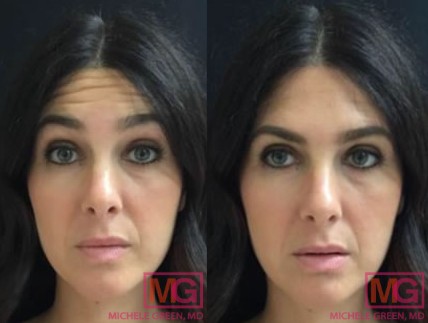
Botox to glabella & forehead lines
What is the procedure for having Botox injected?
Prior to receiving Botox injections, you will first have a consultation with Dr. Green in her private NYC dermatology office. During your consultation, you will have the opportunity to discuss your specific concerns and ideal aesthetic results. Medical photography will be taken to determine the best cosmetic treatment for you and monitor the results. Dr. Green will obtain a thorough medical history, review any previous cosmetic procedures you may have had, and assess your distinct facial anatomy. The cost of Botox will be reviewed and will be based on the areas being treated. Your Botox injections may be performed on the day of your initial consultation or scheduled for a later date, depending on your personal preference. For sensitive patients, a topical anesthetic will be prescribed to your selected pharmacy, which should be applied to the treatment area one hour before your Botox injections.
To prepare for your Botox treatment, we recommend that you avoid taking any blood thinners, including aspirin, Aleve, Motrin, multivitamins, or fish oil, for two weeks leading up to the treatment to reduce the risk of bruising at the injection sites. Dr. Green will mark the injection sites and perform the procedure using a small needle. An icepack will be applied to the treatment area immediately after the procedure to reduce any potential swelling. It is important to remain upright for four hours after your Botox injections and avoid aerobic exercise for 24 hours. Finally, Dr. Green often has patients return in two weeks to evaluate the cosmetic results and see if any additional Botox is necessary.
When does Botox kick in?
Patients should not expect their Botox to “kick in” immediately. Botox injections take a few days to “kick in” and start working. Patients can expect to see and feel the full effects of Botox treatment two weeks after the initial injections. Dr. Green recommends that all of her Botox patients return to her two weeks after their cosmetic injections to ensure that their Botox treatments have been effective and that they have the best results.
What is the downtime after Botox injections?
Botox injections are quick and easy, with little to no downtime. Immediately after injections, patients can have some swelling at the injection site, which resolves within the hour. There is a chance that bruising can develop at the injection site, but this bruising will resolve quickly over the next few days. We advise all patients to refrain from any blood thinners, vitamins, or fish oils for one week before the procedure to lessen the risk of bruising at the injection site.
Does Botox hurt?
Botox injections are relatively pain-free. They are performed quickly with a small needle to minimize pain and discomfort. However, some patients feel some discomfort from needles or injections. If this is the case, we suggest applying a topical numbing cream to the treatment area for one hour before your Botox injections. Ice packs are applied to the treatment area immediately after Botox injections to minimize any swelling or bruising.
What are the side effects of Botox?
Side effects of Botox include:
- Localized swelling
- Bruising
- Headache
- Flu-like symptoms
- Dry eyes or excessive tearing
- Drooping eyelid or ptosis
- Double vision or blurred vision
Immediate allergic reaction side effects that require immediate medical help include:
- Itching
- Rash
- Red itchy welts
- Wheezing or Asthma symptoms
- Dizziness
Rare side effects of botulinum toxin products may cause:
- Muscle weakness
- Trouble breathing, talking, or dysphagia (trouble swallowing)
- Vision problems
- Bladder incontinence (loss of bladder control)
- Hoarse voice
- Neck pain
- Paralysis
- Antibodies to Botox – Some patients receiving injections of Botulinum toxin type A develop antibodies to the toxin, making subsequent treatments ineffective.
If you develop any of these serious side effects following Botox, further injections of Botox should be discontinued, and you should contact your treating physician.
Can Botox cause headaches?
Some patients may experience mild headaches after having Botox injections in the face, although this is not a common side effect. Studies have shown that patients who have Botox injections for the treatment of severe migraines are most likely to experience mild headaches as a side effect of treatment.
Important safety information for Botox
Patients should not receive Botox if they are allergic to any of the ingredients in Botox in the medication guide for Botox or have had an allergic reaction to any other botulinum toxin product such as Myobloc, Dysport, or Xeomin. It is important to remember that Botox is a prescription medicine that is injected into the muscles and can have potential side effects like any other medication. Botox injections should not be done when patients are pregnant or breastfeeding. Dr. Green will review your medical history and current medications before treating you with Botox injections for facial wrinkles.
It is important to tell Dr. Green if you have any muscle nerve conditions such as ALS (Lou Gehrig’s disease), myasthenia gravis, or Lambert-Eaton syndrome. Always let Dr. Green know if you are taking any prescription medications (including muscle relaxants, antibiotics for infection, allergy or cold medicines, sleeping pills), herbal supplements, or over-the-counter medications, which could potentially interact with your Botox treatment. It is always advised to discontinue any blood thinners for at least one week before your Botox injections.
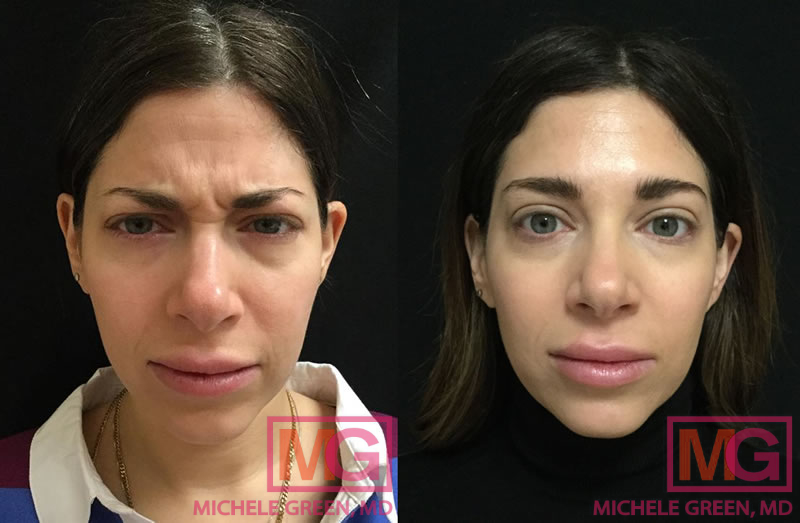
Patient received Juvederm for lips and Botox injections for wrinkles
Is Botox Safe?
Botox is entirely safe, provided the procedure has no medical contraindications and an experienced, qualified healthcare provider performs the treatment. Although many patients are initially frightened to hear that they are injecting Botulinum toxin, Botox is FDA-approved and very safe. Botox gets directly injected into the muscle to relax the treated area. The few contraindications for Botox are being pregnant or breastfeeding, having an allergy to an ingredient, or specific neuromuscular conditions.
While a majority of Botox patients are female, in recent years, Botox has gained popularity among men, too, with a greater percentage of male patients starting to look at options. In fact, statistics from the American Society of Plastic Surgeons noted a 337% increase in men receiving Botox injections since 2000! Find out more about Botox options for men.
Is Botox FDA-approved?
Before its FDA approval for cosmetic use in 2002, there were clinical trials done to guarantee the safety and efficacy of Botox. A study of over 405 patients with glabellar wrinkles, divided into an experimental group and a placebo group, showed that the injection of Botox was effective for temporarily smoothing out the frown lines for a more youthful appearance. Patients who were treated with Botox injections were satisfied with the outcomes of their treatment and noted a smoother complexion. In contrast, patients who were treated with placebo injections indicated that there was no difference in the appearance of their skin before and after having injections. Before the clinical trials that were performed for the cosmetic use of Botox, the FDA approved Botox injections to treat the neurologic condition of cervical dystonia. Cervical dystonia is a medical condition that causes muscle spasms in the neck and shoulders. Healthcare providers now use Botox to treat an array of conditions, including hyperhidrosis and blepharospasm. To see full prescribing information for Botox injections, visit www.fda.gov or consult with the board-certified dermatologist who will be providing your injections.
Can I get Botox while pregnant?
No. Botox is not approved for treatment in patients who are pregnant. Botox injections are considered Pregnancy Class C, which means no adequate and well-controlled studies have proved it is safe for the fetus. As such, Botox should not be performed on pregnant patients due to potential fetal harm.
Can I get Botox while breastfeeding?
No. Botox injections are not recommended for patients who are breastfeeding. While it is believed to be a safe and effective treatment for many patients, there are no studies that show that Botox injections are safe while breastfeeding.
Does Botox work?
Yes! In order to receive FDA approval, treatments must be safe and effective. In 2002, Botox gained FDA approval. Botox is an injectable treatment with cosmetic and medical applications. It is one of the most popular non-invasive cosmetic procedures worldwide and is considered the gold standard for reducing dynamic fine lines. Botox is an injectable neuromodulator that smooths and prevents wrinkles by inhibiting nerve signals to targeted facial muscles responsible for expression. Botox eliminates fine lines and creates a more youthful appearance by limiting muscle contraction. The effects of Botox can start to work as early as several days following treatment, although it can take up to two weeks for them to fully be observable. The effects of Botox last for up to four months, and most patients have regular Botox treatments every 3-4 months to keep up the best results.
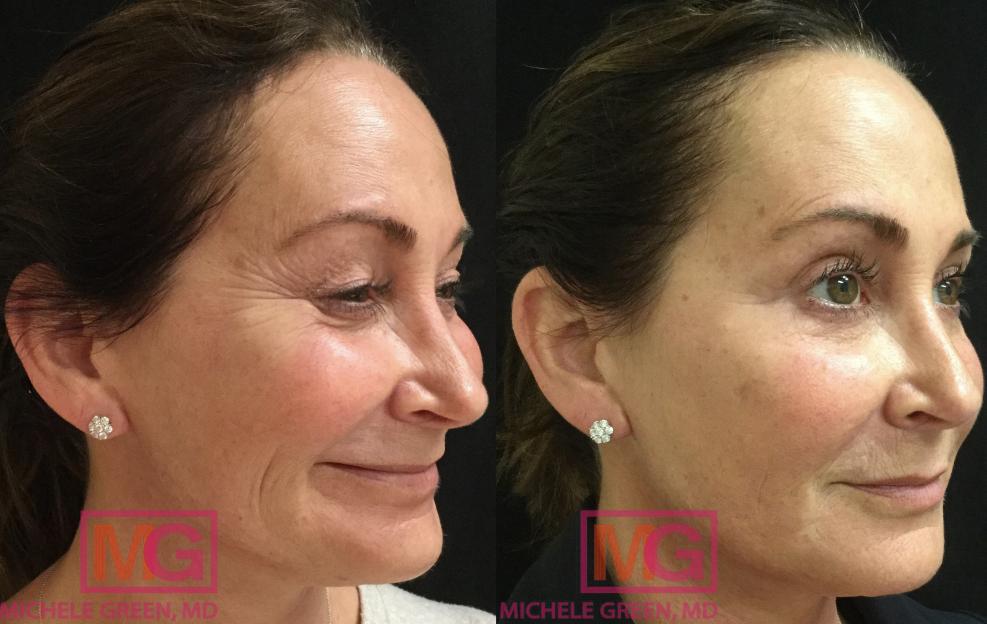
Botox for crows-feet, 2 weeks before and after
How long does Botox last?
The effects of Botox injections typically last for 3 to 4 months. Keeping up with your Botox treatments is a great way to keep the muscles in the treatment area relaxed, and some patients find that with regular maintenance sessions, their Botox injections can last for up to six months. Suppose you are someone who has regular Botox treatments and has noticed that the effects are no longer lasting as long as they previously did. In that case, it is possible that you could have developed antibodies to Botox, rendering the injections essentially ineffective. If this happens, please let Dr. Green know. This issue can easily be resolved by switching to another form of Botox, such as Dysport or Xeomin.
How long does Masseter Botox last?
Botox can be injected into the masseter muscles of the face to relieve TMJ pain and slim the face. Botox freezes the muscles and prevents them from contracting, slowly weakening the muscles to relieve jaw pain. Patients can expect results to last between 3 and 4 months. Many patients opt for regular maintenance treatment with Botox injections for consistent relief from their TMJ. When you consult with Dr. Green in her private dermatology office, she will work with you to develop a treatment timeline for consistent results.
How long does forehead Botox last?
When injected into the forehead, Botox lasts three to four months. The duration depends on the patient’s metabolism, so it can vary, with some patients reporting that their Botox lasts up to six months. Many patients opt for regular Botox treatments to maintain the best cosmetic results.
Does Botox get rid of wrinkles?
Botox can diminish dynamic fine lines and wrinkles that form from repetitive expressions. Botox is an injectable cosmetic treatment classified as a neuromodulator, meaning that it blocks the nerve signals to targeted facial muscle groups, limiting specific muscle contractions. The active ingredient is botulinum toxin type A, a neurotoxin that essentially “freezes” the facial muscles, thus preventing facial lines caused by making facial expressions. When Botox is injected into the facial muscle at the eye’s corner, the treatment blocks nerve signals to the injection site, which relaxes the muscle, smoothing the skin and erasing the fine lines over time. However, when patients have deep wrinkles, Botox may not be enough to smooth the wrinkles fully. When this occurs, patients often benefit from additional cosmetic procedures, such as lasers or fillers. When you consult with Dr. Green in her boutique dermatology office in NYC, she will develop an individualized treatment plan suited to your aesthetic goals.
Is Botox preventative?
Yes! Botox injections can be used as a preventative measure against the development of fine lines and wrinkles. Dynamic wrinkles form due to the skin folding during muscle contractions. If the muscles cannot contract, then the skin does not crease to form wrinkles. The injection of preventative Botox has been increasingly trendy thanks to celebrities and social media influencers openly boasting about the benefits of having Botox treatments. Botox is indicated for patients who are at least 18 years old, and patients as young as their mid-20s often choose to take advantage of preventive or “baby” Botox to keep fine lines from forming in the first place. If you are interested in preventing wrinkles from forming in the first place, schedule a consultation with Dr. Green in NYC.
Will Botox get rid of wrinkles?
Botox can smooth out and remove fine lines and dynamic wrinkles. By “freezing” the muscle, Botox allows the skin to bounce back and smooth the developing wrinkles. As we age, the dynamic fine lines may develop into static, deeper wrinkles. Botox may improve these lines, but often, patients benefit from additional non-invasive treatment options.
Will Botox lift eyebrows?
A Botox brow lift is a common cosmetic procedure performed in the office of Dr. Michele Green. A Botox brow lift is an injectable treatment that will remove forehead wrinkles and fine lines, provide a lifting effect for the eyebrows, and minimize the appearance of upper eyelid hooding. Brow lifts with Botox injections are often preferred to surgical brow lifts, which can result in a look that is unnatural or “surprised.” If too much Botox is injected into the forehead, however, the brow can actually look heavier and move the eyebrows down, resulting in the eyes looking smaller. For this reason, it is essential to consult with an expert injector and board-certified dermatologist who understands the anatomy of the facial muscles and knows exactly where to inject to provide the best cosmetic results. Dr. Green in NYC is an Allergan platinum injector with decades of experience performing the best Botox injections in the city. If you’re interested in having a Botox brow lift, schedule a consultation with Dr. Green in her boutique dermatology office in the Upper East Side neighborhood of Manhattan.
Will Botox help TMJ?
Yes! Botox injections into the masseter muscle work wonderfully for the management of TMJ symptoms. Characterized by tenderness along the jawline, aches around your ear, pain in the joints of the jaw, chronic migraines, and jaw dysfunction that can lead to difficulty chewing and opening or closing the mouth, TMJ can be a debilitating disorder. Botox injections for TMJ work by “freezing” overactive jaw muscles. It takes 1-2 weeks for the full effects of the Botox to become noticeable. Results typically last for 4-6 months, with most patients choosing to engage in maintenance sessions on a regular basis in order to keep up the best effects. Although Botox for TMJ may be offered by your dentist or a nurse injector at a medical spa, it is important to consult with a board-certified dermatologist, such as Dr. Michele Green in NYC. Dr. Green was among the first dermatologists in New York to offer cosmetic Botox injections to her patients, some of the most discerning men and women from around the globe.
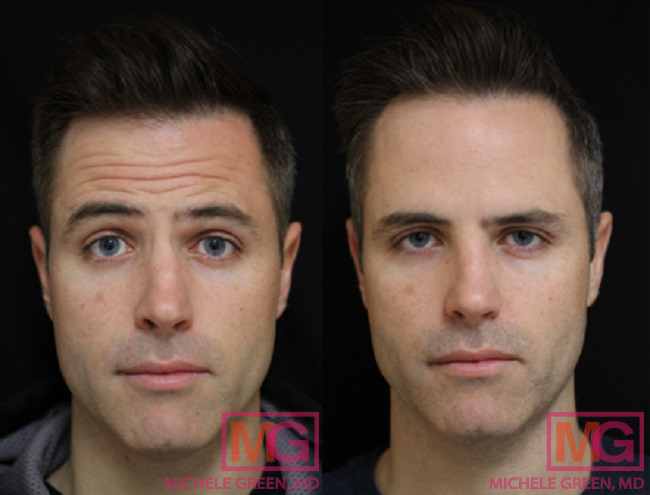
25-34 year old male, Botox before and after
Where to get Botox on the face?
The area(s) of the face where you get Botox injections should be determined with Dr. Green during your consultation in her private dermatology office in the Upper East Side neighborhood of Manhattan. The severity of the dynamic wrinkles present, as well as individual facial anatomy, have an impact on where Botox should be injected into the face.
Botox can be used in the following areas of the face:
- Forehead lines
- Frown lines between the eyebrows
- Crow’s feet around the eyes
- Bunny lines
- Brow lift
- Lip line for Lip Flip
- Smoker Lines around the mouth
- Chin Dimpling
- DAO muscles for a downturned mouth
- Masseter muscles for Facial Slimming and Temporomandibular joint disease (TMJ)
What is masseter Botox?
Masseter Botox is used to relieve temporomandibular joint disorder (TMJ) and to slim the face. TMJ pain often occurs due to overactive masseter muscles, leading to pain and discomfort. As a neuromodulator, Botox can weaken the muscles to decrease the associated pain. Botox acts at the neuromuscular junction to block the nervous signal that causes the muscle to contract. By blocking the masseter muscles, Botox effectively diminishes the pain caused by the hypertrophic muscle. With consistent Botox injections, the muscles atrophy and become less active for long-term relief. Many patients receive their masseter Botox injections every 3-4 months to maintain pain-free results.
How much are Botox injections?
The cost of having Botox treatment may vary depending on factors such as the experience level and skill of the injector and the geographic location of the office in which you are being treated. Some clinics charge Botox based on the units used, and other offices charge Botox injections based on the number of areas treated. The experience and artistry of the injector determine the best Botox. Dr. Michele Green is an internationally renowned board-certified cosmetic dermatologist with decades of experience providing Botox. She was among the first in NYC to incorporate cosmetic Botox injections into her private practice in Manhattan’s Upper East Side neighborhood. As a master injector of Botox with over two and a half decades of experience, she offers what has been described as the “best Botox in New York City.” When you consult with Dr. Green for your Botox treatment, she will work with you to determine a personalized facial rejuvenation approach that best suits your needs, goals, and budget.
Will Insurance cover Botox?
Botox can be used for cosmetic and medical purposes, so in some cases, insurance will cover Botox injections. For example, insurance companies may cover Botox injections for patients with neurologic conditions, such as migraines. When Botox is used for cosmetic purposes, insurance companies often do not cover the injections. The best way to determine if your Botox injections will be covered by insurance is to contact them to determine your health insurance coverage.
Who uses Botox? Where can I get Botox?
Botox has become an incredibly popular cosmetic treatment since its FDA approval for treating wrinkles in 2002. Due to its popularity and a high demand for treatment, there is an increasing number of medical spas that offer Botox injections. The risk of experiencing unwanted and adverse side effects increases exponentially when an unqualified or inexperienced injector performs treatment. It’s best to have your Botox injections provided by a board-certified dermatologist in a medical setting to guarantee that your procedure is performed appropriately, using the proper injection technique. Although it may be more inexpensive to have treatment with a nurse injector or aesthetician, Botox injections can be dangerous if not done properly. Dr. Green in New York City is an internationally renowned board-certified cosmetic dermatologist with over 25 years of experience providing the best Botox injections for patients from around the globe.
Can aestheticians inject Botox?
Botox injections are outside the estheticians’ scope of practice, so they are not allowed to inject Botox. Only medically trained personnel, such as a nurse, physician, or physician assistant, can inject Botox.
Med spas versus a healthcare provider for Botox
Med spas and clinics have nurse injectors, mainly doing the Botox injectors. There is a physician who is legally affiliated with the clinic but is not doing the injections or procedures themselves. Many of these PAs and nurses take a weekend course in order to start administering Botox. When you consult a private physician who is a board-certified dermatologist, like Dr. Michele Green, you know that she has over 25 years of experience and training behind her.
Why choose Dr. Green for your Botox in New York City?
It is sometimes difficult to know which healthcare provider to choose to have your cosmetic procedures performed. Many med spas and clinics offer “free consultations” to draw patients into their clinics. They may advertise that you are having Botox injected but often use less expensive neurotoxins in its place. Having Botox with an experienced injector is important to avoid unwanted side effects, guarantee safety, and achieve optimal results. Do your research through Google and other authentic resources. Make sure you choose a board-certified physician, like Dr. Michele Green, for Botox injections. Dr. Green was among the first dermatologists in NYC to offer Botox injections and has over two decades of experience in cosmetic facial treatments to give you the absolute best Botox results.
Can you work out after Botox?
Dr. Green recommends avoiding heavy exercise for 24 hours after Botox injections. Working out increases blood flow, which can worsen any associated swelling or bruising and potentially increase their duration. Additionally, saunas and steam rooms should be avoided for 48 hours after cosmetic injections, as this leads to swelling of the treatment area.
Can you drink alcohol before and after Botox injections?
It is best to refrain from drinking alcohol for 24 hours before your Botox injection and for one day after your treatment. Alcohol can worsen bruising by thinning the blood. To avoid any unwanted bruising, it is best to refrain from drinking alcohol around your Botox injections.
Can you shower after Botox?
Yes! Taking a shower after Botox will not affect the results; however, be careful when washing the face. Do not scrub the treated areas with a lot of pressure, as that can cause Botox to migrate. For example, after receiving Botox on the forehead, you should gently wash the area upward.
Can you fly after Botox?
After receiving Botox, it is safe to fly. The negative cabin pressure when at high altitudes will not affect the Botox.
Can Botox cause cancer?
No! Botox injections do not cause cancer. Botox has been FDA-approved for over 20 years, and there is no evidence that Botox causes cancer. The use of Botox has been studied extensively since its discovery, and there is no detectable link between Botox and cancer. Patients should not fear Botox as it has been proven to be a safe and effective treatment that has reduced and prevented the signs of aging for decades without any association with cancer.
Do you tip Botox injector?
You do not need to tip your Botox injector. Board-certified dermatologists or plastic surgeons often perform Botox injections, and you should not tip them for their services.
Are Botox injections permanent?
No. The effects of Botox injections, unfortunately, are only temporary. Botox injections’ cosmetic benefits will usually last three to four months. Patients can maintain their results by electing to have a regular “touch-up” treatment session of Botox injections with Dr. Green. More permanent cosmetic procedures are often surgical, though not always preferred. Over time, as aesthetic tastes change and signs of aging continue to develop, patients have more control regarding their appearance with semi-permanent cosmetic treatments. Additionally, Botox and other noninvasive, semi-permanent cosmetic procedures are painless and require no downtime compared to surgical procedures. Patients with a busy schedule often prefer to have procedures with minimal downtime and appreciate the fact that they can achieve a more youthful appearance quickly, easily, and without any discomfort.
What is hair Botox?
Hair Botox is not what it sounds like. Hair Botox has nothing to do with the injectable neurotoxin used to eliminate the appearance of dynamic wrinkles. It is called Hair Botox because of the stunning, refreshed results, just like the incredible results from injectable Botox for the face. Hair Botox refers to a deep conditioning treatment that relies on ingredients such as antioxidants, vitamin B5, vitamin E, and collagen complex. The treatment helps to repair damaged strands that have endured heat and stress, helping to hydrate and smooth the hair. Hair Botox differs from a keratin treatment in that the active ingredients are non-chemical.
What is the difference between Botox and Dysport?
Botox is an injectable neurotoxin that essentially ‘freezes’ certain facial muscles related to expression. Dysport, Jeuveau, Xeomin, and Daxxify are all neuromodulators like Botox that can be used to achieve similar results. These neuromodulators are essentially interchangeable and can be used to achieve comparable cosmetic results or manage symptoms of a variety of medical conditions. The main difference between the neuromodulators is the presence or absence and type of additive proteins included. Although there is only one official injectable with the brand name Botox cosmetic, these other brands of neuromodulators are comparable and can be used to treat the same concerns.
Is Dysport better than Botox?
Both treatment options are equally good. Botox and Dysport are incredibly similar and can often be used interchangeably in facial rejuvenation treatment. They are both injectable neurotoxins that work cosmetically to smooth wrinkles. The primary difference between Botox and Dysport is the type of complex protein attached to the botulinum toxin molecules. The protein attached to Dysport allows it to diffuse 1-3 cm from the injection site, while the protein attached to Botox allows it to diffuse just half a centimeter. In addition to affecting the diffusion of the neuromodulator, the complexing protein can affect the Botox duration and strength. With repeated injections of the same neuromodulator, some patients can develop antibodies to the complexing protein attached to the complex. When this occurs, patients become resistant to the effects of the toxin, leading to weaker and shorter results. While Dysport and Botox both have the risk of developing resistance, Xeomin does not have this risk because it lacks these proteins. Dr. Green offers Botox, Dysport, and Xeomin injections to patients who visit her NYC-based practice and will help you determine which injectable is right for you.
What is the difference between Botox and Xeomin?
Xeomin, like Botox, is an injectable neurotoxin used to treat dynamic fine lines and wrinkles. Botox and Xeomin can be used interchangeably. They are both derived from type A botulinum toxin, so they interact with the neuromuscular junction in the same way. The primary difference between these neuromodulators is the protein attachment. Xeomin does not have any complexing protein attached to the botulinum toxin, while Botox has an added protein. This leads to Xeomin diffusing less than Botox, requiring more injection sites to cover larger muscles.
Additionally, while patients can build a resistance to the added protein in Botox, they cannot build up a resistance to Xeomin. Some patients develop antibodies to the complexing protein in Botox, leading their body to neutralize the drug quicker, causing the duration to decrease and the results to be underwhelming or ineffective. Because Xeomin is free from these complexing proteins, it is not possible to develop resistance to Xeomin.
What is the difference between Botox and Daxxify?
Botox and Daxxify are both neuromodulators that safely and effectively reduce dynamic wrinkles. Daxxify received FDA approval in 2022 for the cosmetic reduction of glabellar wrinkles. Unlike Botox and other neuromodulators, Daxxify has a unique peptide structure that is stable at room temperature and does not require albumin to protect it. Rather, Daxxify has a proprietary peptide that aids stabilization and receptor binding. The unique structure of Daxxify binds tighter with the neuromuscular junction for longer-lasting results. Daxxify is reported to last for six months, compared to Botox, which lasts 3-4 months. However, in clinical practice, no significant longer-lasting results have been observed.
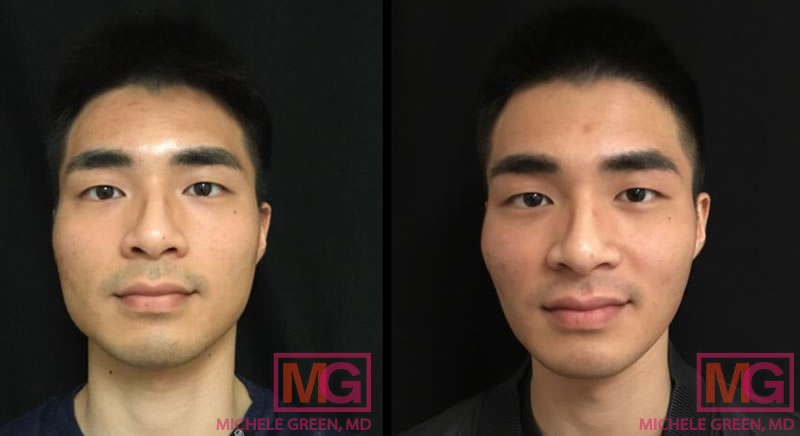
How do I get started with Botox injections today?
If you’re frustrated with the appearance of your frown lines, crow’s feet, neck creases, chin dimples, or wide jawline, there is a quick and easy noninvasive cosmetic solution that can help — Botox! Botox is the gold standard for treating and preventing dynamic fine lines and wrinkles. It is one of the most popular non-invasive cosmetic treatments worldwide due to the ease of injections, lack of downtime, and consistently stunning results. Dr. Green was among the first physicians in New York to offer cosmetic Botox injections to her patients and is known for providing the “best Botox in New York City.”
Dr. Green is an internationally renowned board-certified dermatologist with over two and a half decades of experience providing some of the world’s most discerning individuals with the best non-invasive cosmetic treatments, including Botox injections. Dr. Green takes a holistic approach and embraces a less-is-more philosophy regarding facial rejuvenation, customizing each patient’s treatment plan to meet their needs best and achieve optimal cosmetic results. She is consistently identified as one of NYC’s best dermatologists by Super Doctors, New York Magazine, and Castle Connolly for her dedication to her patients and expertise. To find out more, please get in touch with our NYC-based office today or call 212-535-3088 to learn more about whether Botox or a combination of Botox injections with dermal fillers such as Juvederm, Sculptra or Restylane, along with our extensive cosmetic treatments may be the best choice for you.
Related Topics
- Botox Treatments for Masseter Muscle
- Botox for lip lifts and lip augmentation
- Best Botox Options for Male Patients
- Compare Botox & Dysport
- First time getting Botox? Read common questions.
- Botox for Brow Lifts & Glabella (Forehead)
- Botox for Palmar Hyperhidrosis (Sweaty Palms)
- Botox for Migraines
- What is Micro-Botox, Find out More
- Botox for Jaw Clenching
 212-535-3088
212-535-3088 